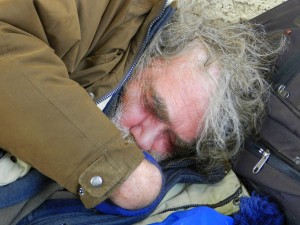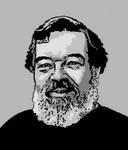
What would Jesus do?
Get to the Modesto Gospel Mission early enough on a winter morning and you see the overnight “guests” leaving the building. These are the homeless.
The rules say they have to be off the property by 7:30, and the rules are strictly enforced. Many of the men who emerge from the building every morning don’t look homeless, maybe because a few actually have jobs, and maybe also because these are people who, for the most part, are still trying.
Some of the men defeat all expectation. One emerges every morning wearing suit pants and a warm wool shirt. As soon as he’s outside he pulls a sterling silver cigarette case from a shirt pocket, extracts a cigarette, and lights up. The cigarette case seems as out of place as a Ming vase at a yard sale, but this man has an air of command and ease when using it.
Another man emerges impeccably groomed and clothed. His haircut looks expensive and well maintained and his Van Dyke beard is meticulously trimmed. Clothing and shoes are expensive and in tune with the season. Come summer, he will sport Royal Robbins clothes, Asolo hiking boots, a Swiss Army backpack, and a tightly rolled sleeping bag. No one knows where he gets his clothing and no one knows where he spends the day.
Each of these men has a story, but the stories may or may not be accurate; they’re told by others who frequent the Mission. In the story of the man with the cigarette case, he’s a former successful executive who is going through a costly divorce and all his assets are tied up until judgment is passed on the divorce proceedings.
The well-groomed man of fashion is supposedly schizophrenic and dysfunctional except insofar as appearances go.
Others have different stories, often involving poor health, lost jobs, divorces, and petty crimes. Those with jobs don’t make enough to afford housing, sometimes because they’re paying child support, owe too much money on installment debt, or simply don’t manage well.
A few of the Mission’s visitors have alcohol and drug problems, or a history of such problems, but not as many as one would suspect. Many of the alcohol and drug users come in only when completely destitute, or when they’re too physically ravaged to stay outside. As a rule, they don’t like places where they can’t drink or use, and especially don’t like being proselytized.
A certain percentage are mentally ill, but again, the mentally ill tend not to want to be around people and places that have expectations they cannot meet, so they often prefer to stay outside unless they’re extremely hungry, wet, or cold.
The variety of people classified as “homeless” tends to operate against our notion of homelessness in general. Especially among those who use the Mission, a fairly large number truly seem to be, “down on their luck.” In many cases, it’s surprising they keep trying, given their health problems, low incomes, educational disabilities, and lack of opportunities and resources.
During the Great Depression, people who were destitute and out of work weren’t accused of lacking character or moral fiber. It was understood that lack of opportunity was the major factor in their plight. In the San Joaquin Valley, also known as the “Appalachia of the West,” social factors are rarely cited as contributing to the huge homeless population.
Instead, most homeless are assumed to be alcohol and drug users. Estimates vary, but most local experts figure that alcohol and drug abusers may account for about one third of the homeless population. Without closer study, it’s difficult to calculate the percentage of addicts because addiction and mental illness often go hand-in-hand.
No question many on the street are mentally ill. Legend has it Ronald Reagan closed the mental institutions and put them on the streets. The truth is more complicated.
In the late 70s and early 80s, the wide professional consensus was that mental illness could be treated with new classes of drugs, family help, and community centers. Many institutions were closed nationwide.
Anti-tax and anti-government attitudes of the times resulted in far too little money for the kinds of community centers needed to address mental illness, and a new focus on character and family values left many of the mentally ill adrift in a world without remedy. They were often viewed as people who had chosen a homeless “lifestyle.”
Many professionals knew early on that it had been a mistake to think drugs and family would remove the need for institutions, but once the paradigm of treatment had been established, it was impossible to change, especially given people’s new attitudes about government, taxes, and family values.
In fact, when treatment fails celebrities like Robin Williams, Phillip Seymour Hoffmann, and David Foster Wallace, we shouldn’t believe it will work with people with far fewer resources. Rehab programs and treatment for mental illness fail much more often than succeed, especially with the homeless, but we persist in spending billions on programs and treatments that don’t work.
Up close, the homeless problem is both more complex and simpler than it appears from a distance. It’s more complex because up close we learn there are many factors in homelessness, and the face of each homeless person is unique. It is simpler because once we realize that the homeless have no toilets, no showers, no refrigeration, no storage facilities, and almost no money, we begin to understand how much a burden each day homeless becomes and how difficult it is to escape.
If poverty, mental illness, addiction, lack of opportunity, and insufficient social services aren’t enough of a factor in keeping homeless rates high, consider also the stigma of homelessness.
When homeless people filled our parks and other public places this summer, they were treated as a plague. Though police say the homeless are seldom guilty of crimes and vandalism in public places, they are routinely blamed. And though they have as much right to be in parks as anyone, they are now systematically discouraged from using the few places where they might find toilets and wash basins.
We have become accustomed to believing, “It’s their own damn fault,” and “It’s not my problem.” As the homeless population grows more and more visible, we begin to realize both claims are mistaken.
When we housed the mentally ill and treated addiction as an illness rather than a moral failing, we didn’t just have fewer public problems. We also showed a compassion gone missing today.
Even many devout Christians have taken to quoting Jesus to justify their indifference to the plight of the homeless. They cite Jesus’s words that, “The poor will always be with us,” as proof there are no social remedies for poverty and homelessness.
Some read the words differently. They say Jesus understood the poor are always with him because he is their hope, redemption, and salvation.
It’s not likely many of the homeless men leaving the Modesto Gospel Mission every cold morning think about Jesus when back on the street. Almost all are without transportation and either begin the long hike across town to the few places where they can find food and restrooms, or head for a park, alleyway, or sheltered space between buildings to spend the day waiting until it’s time to go back inside.
Next: Part III: Just the Facts

I know a homeless couple, who individually could get services, but typically refuse help that would exclude the other person.
One of them is diabetic and his meds should be refrigerated, but due to homelessness, that isn’t possible for him. He’s a fairly young man, yet I expect to read his obituary because of his inability to manage his illness properly.